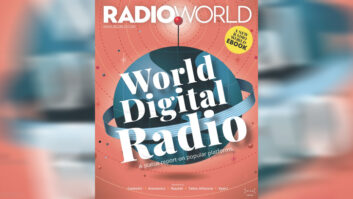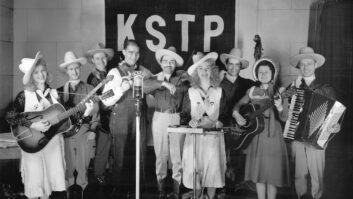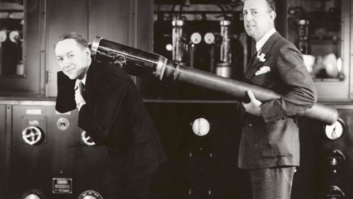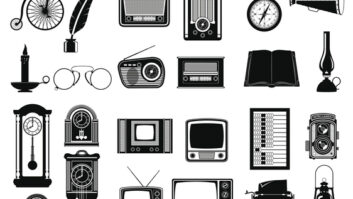Longtime radio broadcast equipment sales executive John Abdnour has retired. The 67-year-old’s career has extended from the days of mammoth multi-rack automation systems and analog cart machines to high-power solid-state transmitters and IP connectivity.

He has been working in radio broadcasting for five decades, most recently as a regional sales manager in the Asia/Pacific region for Nautel. A one-time employee of automation company SMC and tape cartridge maker International Tapetronics (ITC), he went on to work as Midwest regional sales manager for Collins/Continental for 22 years and national accounts manager for Broadcast Electronics for eight more.
“Even with exciting emerging technologies, the most efficient and reliable method of reaching the masses is with a well-engineered FM, MW-AM or SW radio station,” Abdnour told me in an email informing Radio World of his retirement.
I followed up to ask him for more about his career.
McLane: You started in radio as a part-timer … where was it and in what kind of position?
Abdnour: In the 1950s and ’60s, many local radio stations sponsored a broadcasting club at their local high schools to mentor young people for possible careers in the industry. Station WIZZ (a 500-watt daytimer with a Class A FM) in Streator, Ill., began the practice when they signed on in 1953 and launched the careers of a number of people. They would also hire one of the students to work part time, doing everything: announcing, “riding gain” during remotes, doing the evening programs, writing news, learning engineering, filling the Coke machine!, etc.
That was me in 1966, doing just about everything to learn the business. The glow from inside the Gates BC500GY was mesmerizing, the bug was caught and radio was in my blood. The influence, reach and responsibility of a radio station was, and still is, magical. Eventually, this led to a full-time job in programming and engineering before moving into manufacturers’ engineering and sales in 1973.

Circa 1969.
McLane: Where did you grow up and where do you live now?
Abdnour: I grew up and currently live in Streator, Ill., about a hundred miles southwest of Chicago and, of course, we were listening to “The Big 89” WLS or “Super CFL,” WCFL during the 1960s. There were hundreds of us around the country who had visions of being the next Clark Weber, Ron Riley, Larry Lujack or Wolfman Jack. It didn’t happen.
McLane: What do you think folks who designed those SMC and ITC systems back in the day would say about today’s automation systems?
Abdnour: Those of us who worked in the automation and tape cartridge business knew we were “state of the art” at the time; but, in 1975, we’d probably look in disbelief if someone had told us the day was coming when the capability of a 10-rack automation system would be dwarfed by that of a desktop PC or that you could put the content of thousands of tape carts in your pocket!
It does make you think about what will come in the next 50 years.
McLane: Working at Collins, Continental, BE and Nautel, you’ve probably had your hands in some very interesting RF projects. Which one or two stick with you as particularly notable (in scope, in design, in any unusual aspects)?
Abdnour: Throughout the years, there were a number of projects which were very interesting.
Besides AM/FM broadcasting, the shortwave and scientific applications at Continental were always great to watch mainly because of the very high power, huge sizes of some of the components, and the special uses. It was exciting to be part of Broadcast Electronics when the IBOC Alliance was building an infrastructure as the first stage in promoting, developing and growing HD Radio. We provided gear to put hundreds of IBOC (HD) signals on the air.
At Nautel, providing India with thirty-three 100, 200 and 300 kW MW-AM transmitters as All India Radio transitions to DRM30 is the single largest DRM effort in the world. Those transmitters will serve 1.5 billion people, many in remote regions.

Key broadcast elements of the era are visible in this studio shot from about 1970.
McLane: Favorite memories?
Abdnour: In the ’80s, there was a CE at a station who left disgruntled or was fired. His last act before turning in his keys was to program the dial-up transmitter remote control to call Continental’s technical service number every 30 minutes, most likely to run up the long-distance bill. Caller ID was almost nonexistent then so we didn’t know the location from where the calls came. It took most of the weekend to get into the back door to break the calls.
Then there was the manager of a station who wanted to move his new, four-rack automation system several inches forward. Apparently, he didn’t pay attention in science class when he was pushing at the top of the racks instead the bottom. I can only imagine the shock when it fell on its face — broken plastic and bent metal everywhere.
I made a trip to a small station in the west to find out why an automation system seemed to go into business for itself, advancing and dumping out of programming but only on every other night of the week. I was sitting in front of it, staring at the system on one of those nights when the cleaning person came in and plugged the vacuum cleaner into one of the outlet strips inside the automation racks. Sure enough, as soon as the vacuum started, so did the chaos.
Following the commissioning of an automation system in the mi-’70s, I was puzzled why we couldn’t hear the music on a mono FM radio (stereo radios were rare back then). The station had recorded their own reels of music — dozens of 10-inch reels with hundreds of hours of music — for the system. Tracing backwards, we found that the station had the input of the reel-to-reel recorder wired out of phase! Sigh.

Abdnour was featured in a mid-1970s ITC brochure.
McLane: And about that big India job.
Abdnour: Clearly, the largest project with which I have been involved is that of All India Radio. It began in 2010, when the AIR engineer in charge at the time showed me a map on his wall in Delhi of some 70 transmitter sites and said they “were going to convert all of them to digital.” Some of the sites were upgrades while about half required new transmitters, ATUs, loads, etc.
Working with a team which included the Nautel project manager and engineers, Comcon (Nautel’s representative in India), Altronic Research, Kintronic Labs, Digidia and AIR engineers, Nautel was successful in the tender for 27 high-power (100, 200 and 300 kW) MW-AM transmitters followed by a recent order for six more 100 and 200 kW transmitters (almost 6 MW of total RF power!).
The transmitters are located across India and serve one and a half billion people. Nautel supplied the entire systems: transmitters, electrical, feeder systems, antenna tuning units, loads, etc. As well, we hosted a number of AIR engineers at the factory for weeks of factory acceptance testing and training. Nautel and Comcon engineers assisted with on-site commissioning.
The task was daunting but competently handled with excellent planning and deployment. It showed the world our capabilities, but most gratifying is knowing that people who need it (especially in remote areas) will continue to be provided with news, information and other programming vital to their everyday living.

With the late Harry Priester of WLS Chicago, who purchased a Continental 317C-3.
McLane: What do you think will be the biggest technical challenge for radio broadcasters and manufacturers in the next few years?
Abdnour: Probably the biggest challenge for both will be competing with other delivery technologies. However, radio broadcasters are heavily involved in providing content for these services and are embracing them to add to their over-the-air delivery channels. Manufacturers will continue to build on improving already good operating efficiency and on diagnostics to help engineers in maintaining their plants. As the engineering landscape changes, there will need to be expanded efforts to keep sites operating properly. Both broadcasters and manufacturers will continue to work toward the transition to digital whether it is HD Radio, DRM or a combination of both. As digital continues to evolve, we’ll see much more information, programming and data being pushed through the pipe.
McLane: What plans for retirement?
Abdnour: My wife of 40 years, Toni, and I love to travel, to anywhere and at any time, and will continue to do so, but probably largely from the trunk of the car to see parts of this great country and not chasing so many airplanes. We’re also planning to move to the Sunshine State! And I am available to Nautel for contract work for special efforts and show participation.
McLane: What else should we share with readers?
Abdnour: 2016 was my 42nd NAB Show. Witnessing its expansion over the years is part of the excitement of our industry.
Radio is a fascinating, dependable medium. It can reach more people more reliably than any other communication form. I still get a rush when picking a distant signal out of thin air.
John Abdnour welcomes emails; his address consists of his first and last name, no spaces, followed by @gmail.com.







